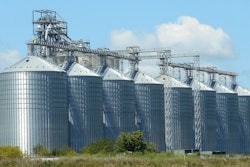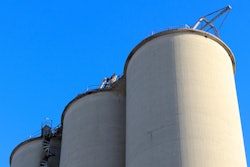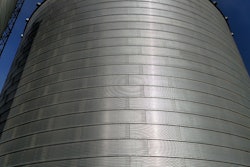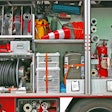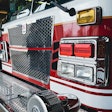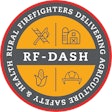
Entering a grain bin may be the most dangerous job an employee will have at a feed mill or grain elevator. Workers who enter grain bins to remove or move grain can be at risk of suffocation, entrapment, falls and other hazards.
In the "2021 Summary of U.S. Agricultural Confined Space-Related Injuries and Fatalities," the latest report from Purdue University, there were 29 grain-related entrapments in 2021. Of those 29 cases, 11 ended with the victim's death. The study notes that these only represent the entrapments that were documented and reported on, but the number of unreported cases is probably much higher.
The industry has made a push to raise awareness of the dangers of entering a grain bin, through programs like Grain Bin Safety Week. And grain handling companies have worked hard to provide education and equipment to rural firefighters and first responders to better prepare them for a grain bin rescue. These efforts seem to be paying off. The report from Purdue noted cases and fatalities have been decreasing since they started compiling the data in 2013.
Keeping workers safe when entering a grain bin is everyone's job. Employers should have a clear policy in place and ensure workers are trained on grain bin entry safety procedures and emergency response plans. If your facility doesn't have a grain bin entry policy, or it needs to be updated, there are key things to keep in mind. The Occupational Safety and Health Administration (OSHA) has several tips for complying with standard 29 CFR 1910.272.
Have a written grain bin entry safety plan
Companies should have a written grain bin entry safety plan to ensure that workers are aware of the hazards associated with working in or around grain storage facilities and to provide clear guidance on how to minimize those hazards. A written safety plan helps to establish a consistent approach to grain bin entry safety that can be communicated to all workers and contractors involved in the operation.
The safety plan should outline the specific procedures to be followed before, during and after grain bin entry. The plan should also identify the roles and responsibilities of all personnel involved in the operation.
By law, employees must be granted a permit before entering a grain bin. A grain bin entry permit typically includes a checklist of safety requirements that must be met before the worker enters the bin (more details and tips on what those requirements should be are below). This may include checking that the grain bin is properly ventilated, the power source is disconnected, and that proper protective equipment is worn. The permit will also include the names of the workers who will be entering the bin and their roles in the operation, as well as the names of the individuals who will be monitoring the workers from outside the bin.
Before issuing a permit, the employer or supervisor responsible for the grain bin operation will review the permit with the workers who will be entering the bin. This review will ensure that the workers understand the risks associated with entering the bin and the procedures they must follow to minimize those risks.
Once the permit is issued, it must be displayed at the entry point to the grain bin, and all workers involved in the operation must be aware of its contents. The permit will be valid for a set period, usually for the duration of the task being performed inside the grain bin.
Wear personal protective equipment (PPE)
Workers who enter a grain bin should wear personal protective equipment (PPE) to minimize their risk of injury or illness. The following PPE should be worn inside a grain bin:
- Respirator: A respirator should be worn to protect against inhalation of dust, mold, and other airborne particles that can be present in a grain bin. Respirators should be selected based on the type and concentration of the hazard and should be fit-tested to ensure proper fit and protection.
- Safety glasses: Safety glasses should be worn to protect the eyes from flying debris, dust, and other airborne particles.
- Hearing protection: Hearing protection, such as earplugs or earmuffs, should be worn to protect against the loud noises that can be generated by grain handling equipment.
- Gloves: Gloves should be worn to protect the hands from cuts, punctures and other hazards.
In addition to these PPE, workers should also wear appropriate clothing, such as long-sleeved shirts and pants, to protect against cuts and abrasions. Nonslip footwear should be worn to prevent slips, trips, and falls.
Turn off power sources
It is crucial to turn off all power sources to a grain bin before entering it to minimize the risk of accidents and injuries. Grain bins may have various types of power sources, including electrical, hydraulic, and pneumatic sources, which can be hazardous to workers inside the bin.
By turning off all power sources to the grain bin, workers can minimize the risk of these hazards and prevent accidental activation of power sources while they are inside the bin.
Use Lockout/tagout procedures
Lockout/tagout procedures are essential to ensure the safety of workers who are working on or around hazardous machinery or equipment. Lockout/tagout procedures involve the following steps:
- Notification: Notify all impacted employees that a lockout/tagout procedure is about to take place.
- Shutting down: Shut down the machinery or equipment by following the manufacturer's recommended procedures or guidelines.
- Isolation: Isolate the machinery or equipment from all energy sources, including electrical, hydraulic, pneumatic, mechanical, and gravitational energy sources.
- Lockout: Lockout the energy-isolating devices with a lock or other suitable device to prevent the release of energy.
- Tagout: Tagout the energy-isolating devices with a warning tag that indicates the equipment or machinery is not to be used until the lockout/tagout procedure is complete.
- Verification: Verify that all energy sources have been isolated, and the machinery or equipment is safe to work on.
- Release: Release stored energy from the machinery or equipment by following the manufacturer's recommended procedures or guidelines.
Never work alone
Employees should never work alone in a grain bin. Having a spotter or observer present at all times when an employee is working in a grain bin in case of an emergency. If a worker is alone in the bin and gets injured or trapped, they may not be able to call for help themselves. Having a second employee to monitor the worker inside the bin for signs of distress, such as difficulty breathing or signs of suffocation. The workers should be communicating any possible hazards or changes to the environment.
Proper ventilation
Ensuring proper ventilation inside a grain bin is essential for the safety of workers who are entering the bin. Grain bins can be hazardous environments because they can contain dangerous gases, such as carbon dioxide, methane and nitrogen, which can accumulate and cause suffocation or other health hazards. Proper ventilation is necessary to ensure that these gases are removed from the grain bin and replaced with fresh air.
Fall protection
Workers who need to climb inside a grain bin should use fall protection equipment, such as a harness. Falls from heights are a leading cause of injuries and fatalities in the workplace. In a grain bin, workers may need to climb ladders or walk on elevated surfaces to perform their work.
Using fall protection equipment can help prevent falls and minimize the risk of injuries. If a worker falls inside a grain bin they can become trapped or engulfed in grain. Using fall protection equipment can prevent falls in the first place and make rescue easier if an employee does become trapped.
In many jurisdictions, using fall protection equipment is required by law for workers who are working at heights above a certain level. Using fall protection equipment in a grain bin can help companies comply with regulations and avoid fines or penalties. Even if not required by law, using fall protection equipment is considered a best practice in the grain industry.
By using fall protection equipment, workers and companies demonstrate a commitment to safety and create a safer work environment.
Stay alert
The final tip is easier said than done, but employees should be encouraged to stay alert when working in a grain bin because it helps them identify potential hazards and react quickly to prevent accidents. Distractions can increase the risk of accidents and injuries, so workers should avoid distractions such as using mobile phones or listening to music while working in a grain bin, as it can divert their attention away from the task at hand and increase the likelihood of making a mistake.
Grain bin accidents can happen suddenly and without warning. Staying alert allows workers to react quickly to an emergency and follow emergency response procedures. In some cases, a worker's ability to stay alert and respond quickly can mean the difference between life and death.
Following these safety tips can help prevent accidents and fatalities when working in or around grain bins. Grain bin entry is a high-risk activity and everyone at the facility has to promote a safety culture that encourages employees to slow down and follow the proper safety procedures.
.jpg?auto=format%2Ccompress&crop=faces&fit=crop&h=48&q=70&w=48)


